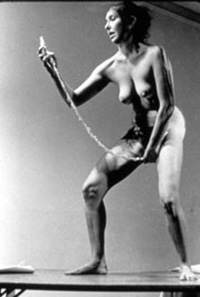“So long as a woman refrains from unsexing herself, let her dabble in anything. The woman of genius does not exist. When she does, she is a man.”—A 19th century commentator
Feminism as we know it today, or the ‘second wave’ of feminism as an ideology, developed in the late 1960s and soon found itself a strong base within every facet of the society, including art, literature, and politics. The historical (often masculine) study of femininity documents feminine identity linked to passivity, nurturing, cooperation, gentleness, and relationship to motherhood, with an emphasis upon the relegation of women to the private sphere, the sphere of domesticity.

Carolee Schneemann’s Interior Scroll.
Feminists and sociologists have challenged the stereotypes relating to ‘femininity’, ‘female identity’, and the binary categories man/mind, woman/nature which dominate many conceptions of sexual difference, including the reduction of sociocultural processes to biological givens. For French feminist theorists (e.g. Cixious, Kristeva), ‘feminine’ is an arbitrary category given to woman’s appearance or behaviour by patriarchy. In this essay, we look at the ‘women’ artists of the 20th century and try to ascertain whether it would be pertinent to term their art as ‘feminine’ or ‘feminist’ as well as challenge the notion or the myth of ‘great’ art, if there is such a thing as the feminine aesthetic and feminist imagery, at the same time raising questions as to who or what makes an artist ‘great’ and trying to destroy the stereotypes associated with feminist art.
Griselda Pollock vociferously states that since the beginning of the women’s movement, one of the major tasks faced by the feminists was to restructure the representation of the female in the various art forms as unfavourable depiction and reading of art history might further the cultural hegemony which has already existed. The notion of free, individual creativity has always been associated with the male, whereas art by women is always accompanied with a feminine adjectival prefix. Women artists have been deliberately kept away from the canon whereas a close scrutiny of the 20th century would provide us with enough examples of consistent and constant contribution by them. There has been substantial amount of literature prior to this, where women artists have been criticised for having a ‘feminine’ aesthetic typifying the paintings presented by them as inferior art. This gender differentiation in turn has played a significant role in hailing the masculine art and upholding it as ‘great’ or ‘serious’, at the same time reducing the so-called feminine art as the ‘other’. Also, any art which challenges the set perceptions of history and tries to provide different explanations is again cast off.

Valerie Solanas’s S.C.U.M. (Society for Cutting Up Men) Manifesto reverses the roles of the sexes.
Valerie Solanas, the radical feminist, in her famous work S.C.U.M. (Society for Cutting Up Men) Manifesto, reverses the roles of the sexes, projecting the man as an essentially weak individual who resorts to “symbolism and obscurity” to prove himself as superior to the ‘other’ (woman), thus creating a divide in order to disguise his own insecurity. She states that ‘Great Art’, which is in actual fact created by men and “that obscurity, evasiveness, incomprehensibility, indirectness, ambiguity, and boredom (present in their art) are marks of depth and brilliance”, is great is told to us by the male authorities and we have no space to challenge their assertions as only those with fine sensibilities can truly appreciate their greatness. She goes on to say that appreciating is the only leisure activity of the so-called ‘cultivated’, that that their inability to create leads them to spectate, that “absorbing ‘culture’ is a desperate, frantic attempt to groove in an ungroovy world, escape the horror of a sterile, mindless existence”. Her radical ideas become very evident when she claims that man being purely sexual and hollow and without the ability to give life cannot aptly depict life in any which way.
Even though Solanas’s work is an interesting read and provides food for thought, one cannot absolutely agree with her as it is highly intransigent and tends to denigrate the male sex in order to prove her point. And the feminist art or the feminist movement at large, as opposed to radical feminism (initially, at least), was certainly not about that but about finding a balance along with creating a niche for women artists who had been marginalised for a long time now. As Shulamith Firestone remarked, “The development of ‘female’ art is not to be viewed as reactionary, like its counterpart, the male School of Virility.”

Judy Chicago, The Menstruation Bathroom, Womanhouse.
Along the same lines as Solanas, Project Womanhouse, where 21 art students from Feminist Art Program at the California Institute of the Arts (CalArts) turned a dilapidated house in Los Angeles into an art exhibit, is perhaps a landmark in revolutionising art and bringing about feminist art and imagery to the forefront. It was started in 1972 by Judy Chicago and Miriam Schapiro at the idea of Paula Harper, an art historian who was teaching at CalArts during that time, to create a collaborative art installation in a house. There were several noteworthy installations such as the Bridal Staircase by Kathy Huberland, where a mannequin bride was placed on the stairs with her long bridal train leading to the kitchen and becoming progressively greyer and dingier along its length; Judy Chicago’s Menstruation Bathroom, which depicted a white bathroom with a shelf full of feminine hygiene products and a trash can full of used feminine hygiene products, the red splayed against the white walls creating a stark impression; and performance acts such as He and She, where actors were seen as having both the sex organs and Birth Trilogy, where performers crawled through a “birth canal” tunnel made of the legs of other women. Faith Wilding’s 15-minute monologue titled Waiting as a part of the performance is also of tremendous significance. This project was fashioned in such a way so as to shock the spectators, to provoke them into a reaction.
And not just Womanhouse, Carolee Schneemann was producing such radical art for a long time before 1972. She is famous for her performance act, Interior Scroll, in which she pulls a scroll of paper out of her vagina, which has text written on it, all the while reading from it to the audience. “I thought of the vagina in many ways—physically, conceptually: as a sculptural form, an architectural referent, the sources of sacred knowledge, ecstasy, birth passage, transformation. I saw the vagina as a translucent chamber of which the serpent was an outward model: enlivened by its passage from the visible to the invisible, a spiralled coil ringed with the shape of desire and generative mysteries, attributes of both female and male sexual power. This source of interior knowledge would be symbolised as the primary index unifying spirit and flesh in Goddess worship.”








